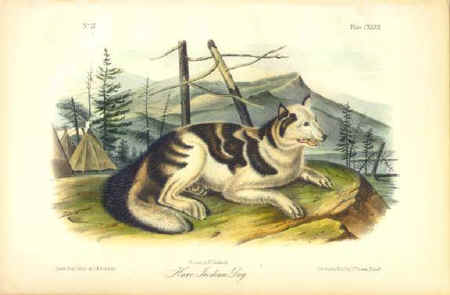By Stephanie Little Wolf
Indeed, the Mtdna (mitochondrial) studies strongly support the hypothesis that paleoamerican and Eurasian domestic dogs share a common origin, both evolving from the Eurasian gray Wolf. No evidence of a separate domestication of dogs from North American Grey Wolves was discovered. Although the haplotypes found in paleoamerican dogs were closely related to Eurasian dogs, some of them formed a unique clad within the main genetic group, (clad 1), which is found only in paleoamerican dogs. This indicates that dogs were present and isolated in the new world for a considerable amount of time. This long period of isolation led to the appearance of a group of genetic sequences (haplotypes) that are similar but very easily distinguishable from dogs from other parts of the world, or from any modern dog population in America today. Indeed, no surveyed modern population of dogs in the United States carries these unique genetic markers in their DNA. American Indian Dogs were extinct early on by the inbreeding and replacement by European dogs. Only the Eskimo dog has survived. Dna evidence links the Eskimo Dog with the Australian Dingo, the New Guinea Singing dog, and the Shiba Inu. The Mexican Hairless or Xoloitzcuintle was present in the Americas long before Europeans arrived, but the genetic lineage shows extreme mixing with European dogs and may not genetically resemble its pre-Columbian ancestors anymore, although reduced dentition and hairlessness are extremely dominant traits, so the dogs strongly resemble their forebears in appearance.
Dogs, Wolves, and Coyotes
At the time of European contact, American Indians were groups of diverse and widely dispersed nations. It is common yet inaccurate these days for them to be discussed as one single population and their dogs do not escape this inaccuracy. In fact, there were many different types of Indian dogs and they were used for a variety of reasons that were as diverse and unique as the people they inhabited the land with. It is also common for modern researchers to site early explorers from the late 1600s to the late 1800s and their anecdotal interpretations of Indian dogs as being almost impossible to distinguish from the wolf. This is also a common mistake and misinterpretation today. Countless times I have heard children, and adults refer to my Alaskan Village dogs as wolves. In fact, Eskimo dogs, huskies and other sled dogs may have fur and vocalizations that resemble their wolf ancestors, but that is about it. Dogs have a shorter stockier build, wider chests and shorter faces and muzzles, with short steep "stops" or angle from forehead to the bridge of the nose.
In all, many dogs filled roles within Indian cultures. Some tribes had rather loose associations with their dogs, some were extremely attached and involved with dogs as pets and or using them for various tasks. Dogs probably tracked game, and packed meat after a hunt. Dogs were eaten by some groups as a food source and some were only consumed ceremonially. Dogs were the playmates of young children and companions to the elders.


5 comments:
Indeed, as the article pointed out, there were strong suggestions that some of the earlier anecdotal recordings by early explorers(ie.g. Hayden, Drake, Brown, Maximillus, and Mathews) who studied the plains indians made note that some tribes such as the Crow, for example had numerous dogs that resembled the wolf. Or "wolf-like" dogs as described by (Hayden?) or others. Its possible that they were "Native American Indian dogs".
However, I don't buy the tenuous crap that a DMarks who asininely believed that such "Native American Indian dogs" were chihuahuas. Which probably were common in Mexico or Central America. But a DMarks didn't bother citing links to support its(he/she?) frivolous claims as noted in your previous blog regarding "Native American Indian dog."
GENO--
The Mexican Hairless or Xoloitzcuintle is the breed that became the Chihuahua. It's one of several breeds that pre-Columbian Indians kept, according to this article.
I don't think anyone claimed that Chihuahuas were the only breed kept by Indians. But they were one of the prominent ones, especially in Mesoamerica.
Anongeno: Why the attack? The Chihuahua-like reference was actually from very old photos I saw in a book about the history of actual Native American dogs.
The dogs I saw photos of were not chihuahuas, but had a definite facial resemblance.
And I can't find Rob attacking my "frivolous" claims in his post about Native American Indian dogs. Yet you claim to have seen this. Actually, I provided some source material and direction for Rob's second post on the issue of Native Americans' dogs.
I think a lot of it is that Indians clearly valued genetic diversity. (Exhibit A: The SEVERE incest taboos.) Hence the fact that the dogs look so much like wolves.
True, Anon. I recall one tribe that shunned a band of Natives for marrying relatives that were too close (the Keoxa).
Post a Comment